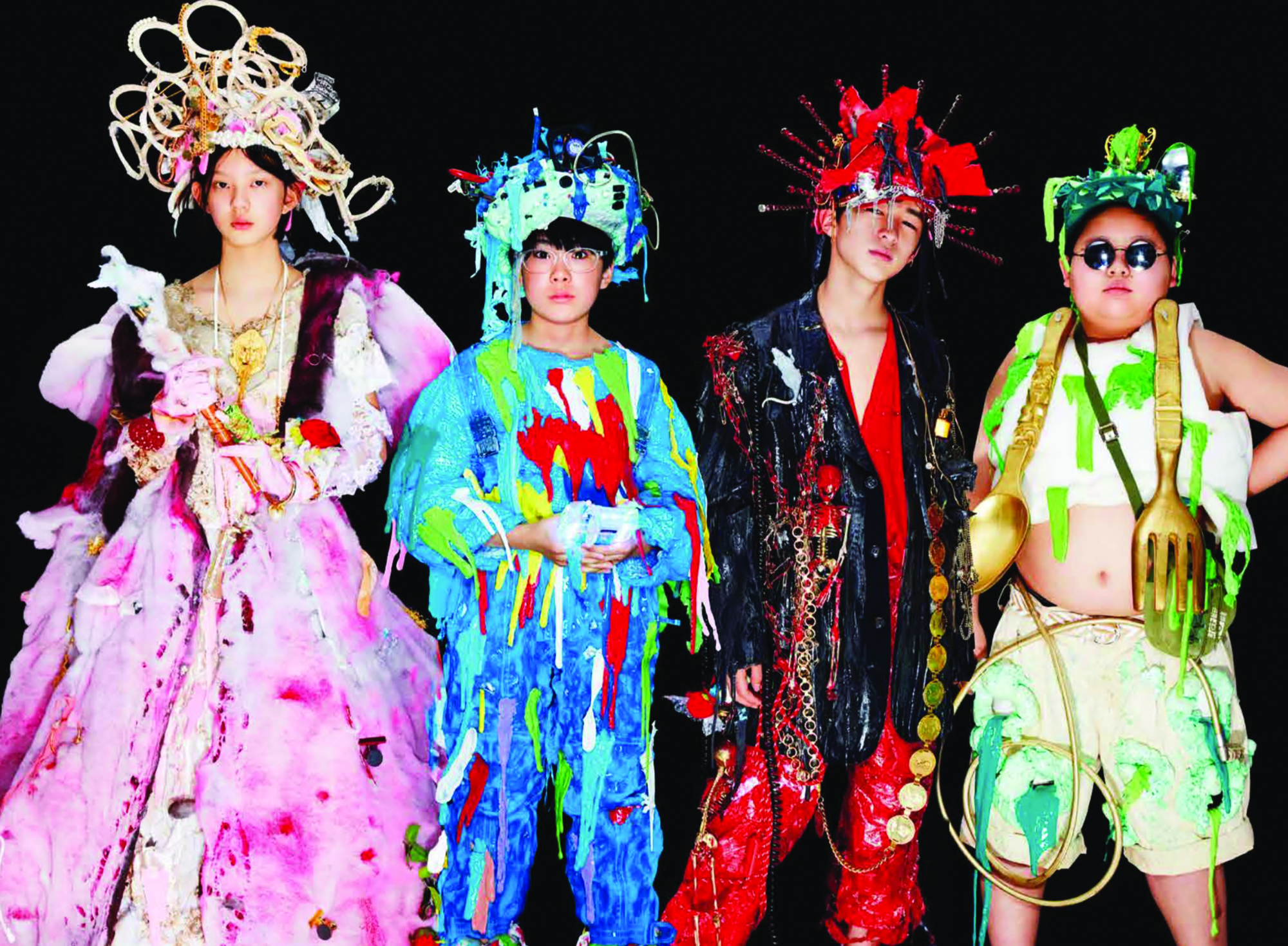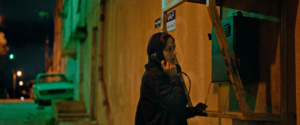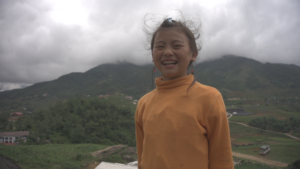We Are Little Zombies (2019) is about a quartet of thirteen-year-old orphans who form a chiptune band. In turn, it’s like a chiptune movie. Katsuya Yamada’s score duly bleeps and blurps, while writer/director Makoto Nagahisa liberally employs a host of cutesy videogame imagery: 8-bit intertitles and title sequences; circle wipes; conversational references to ‘save points’ and ‘end-of-level bosses’; footage deliberately pixelated; characters shown in eye-of-god overheads that render them two-dimensional, Frogger-like figures shuffling through landscapes. Characters herein obsessively play an old handheld game – which shares the same name as the film, and inspires the name of the band within the film – and there’s an early scene of pure vintage-console fetishry. The movie proceeds in ‘stages’, many of which have specific goals; the names of these stages are shown in intertitles that crash onto the screen with crunchy, blockish sound effects. There’s ‘Mission Clear’ banners, a ‘Continue?’ countdown, a ‘Game Over’ sting, a false ending (replete with mock, viewer-confusing credits) and a restart. The final credits move from left to right, echoing the wholly horizontal movement of a side-scrolling game. And the film’s poster announces, wryly: ‘Life is like a shit game’.
Not since Scott Pilgrim vs. the World (Edgar Wright, 2010) has a movie so tapped into the spirit, visual language and deeply existential nature of gaming. And, as in Scott Pilgrim vs. the World, the bright colours, directorial hijinks and gamer gags merely form the stylised presentation for an unexpectedly emotional story. Each movie may, on first blush, seem superficial, but there’s a deep sadness and smart study of human/social behaviour dwelling beneath their postmodernist facades.
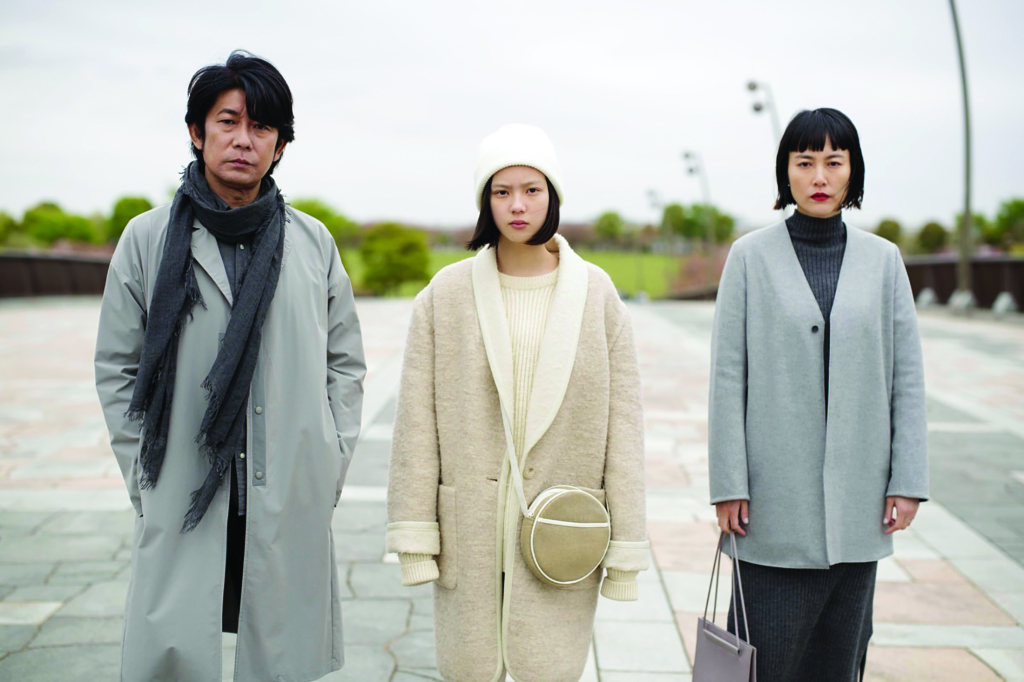
The most simplistic, kinda-condescending reading of We Are Little Zombies is that it’s another example of those ‘crazy Japanese’: Nagahisa – a debutant director with a host of wild music videos and advertisements in his back catalogue – making a movie that fits in a lineage of bonkers cult flicks like Tetsuo, the Iron Man (Shinya Tsukamoto, 1989), Electric Dragon 80,000 V (Ishii Sogo, 2001), The Happiness of the Katakuris (Takashi Miike, 2001), Survive Style 5+ (Gen Sekiguchi, 2004), Funky Forest: The First Contact (Katsuhito Ishii, Hajime Ishimine & Shunichiro Miki, 2005) and Tokyo Tribe (Sion Sono, 2014).
And, well, for those just coming for ridiculous visuals, We Are Little Zombies delivers (Nagahisa, who grew up wanting to be a jazz musician, sounds almost stoner-philosophical when he says he ‘wanted to make it feel like the audience was the fifth member [of the band] and […] like the entire audience was […] one brain’[1]Makoto Nagahisa, via translator, in ‘Berlinale-2019 – We Are Little Zombies’, YouTube, 1 March 2019, <https://www.youtube.com/watch?v=0Mur9RW6GLw>, accessed 25 February 2020 ). In Nagahisa’s prior work, the short film And So We Put Goldfish in the Pool (2017), he and director of photography Hiroaki Takeda flipped the camera upside down, scrawled hand-drawn animation over filmed images and mocked a point-of-view shot from inside a bowling ball rolling down an alley. (The short’s title also alludes to a gesture repeated in We Are Little Zombies, wherein a pet fighting fish is taken from its solitary fishbowl and dropped into a bigger body of water, symbolising stepping out into a larger world, and out from isolation.)
Not since Scott Pilgrim vs. the World, has a movie so tapped into the spirit, visual language and deeply existential nature of gaming … And, well, for those just coming for ridiculous visuals, We Are Little Zombies delivers.
The pair get even more inventive in We Are Little Zombies, their union evoking the experimentation between Wong Kar Wai and Christopher Doyle in the 1990s while definitely showing the influence of Michel Gondry’s whimsical music-vid visions. Wild, wide angles are rapidly cut between with deliberate disorientation. There are shots from inside chip packets, glasses of orange juice, fridges, microwaves. We occupy the interior of a disposable camera and see the eyeballs peering down its viewfinder. A camera sits on top of a coffin being rolled through a crematorium, then positions our perspective inside the pine box. There’s shots from the point of view of koi underwater, coming up to the surface for food. There’s an image approximating vision through a plastic straw, which looks like a rainbow tunnel to a circle of light, and another out to convey the viewpoint of someone both hanging upside down and looking through binoculars. There’s countless GoPro/SnorriCam–shot images – cameras having been rigged to the bodies of our young charges – gazing at their faces as the fixed points of a chaotic world. Cameras sit on the floor (where milk gets spat on the lens) or on eye-of-god high, these divergent perspectives (often literalised by screens) toggled between with abandon. Clip-art imagery is slapped on screen like social-media ‘stickers’, and still photos (including real archival photographs of World War II nuclear bombsites) are positioned in the centre of the frame, stacked atop filmed images. Little Zombies’ songs are presented as manic video clips, and mock internet reaction videos to their music pop up on screen (as do online comments, which are presented via a variety of stylised, theatrical devices). There’s a sequence wherein a stolen truck pilots the kids through a subaquatic realm that may either be inside a bloodstream or in an afterlife that resembles a psychedelic coral reef.
A triangular stairwell is turned into kaleidoscopic geometric patterns, a piano suspended from a crane twirls pirouettes in a sky filled with ominous clouds, and a Venus flytrap closes on a victim in a verdant greenhouse garden. A stop-motion-animated tiger stalks through a funeral, and a similarly animated onstage video-screen talking head plays like a papier-mâché parody of Max Headroom. There’s a psychedelic kids/music show (‘Music Hell’) hosted by a man dressed as a body-painted yellow and blue centaur, his co-host a puppet that’s a snake’s body attached to a hand holding a giant eye (which, in turn, leads to plentiful eye puns). There’s the imagined future of a Where Are They Now?–type TV show, wherein the band return to the public eye as unattractive adults. And, when one character heads into a morgue to identify the bodies of his dead parents, he fantasises he’s in the middle of a TV prank show.
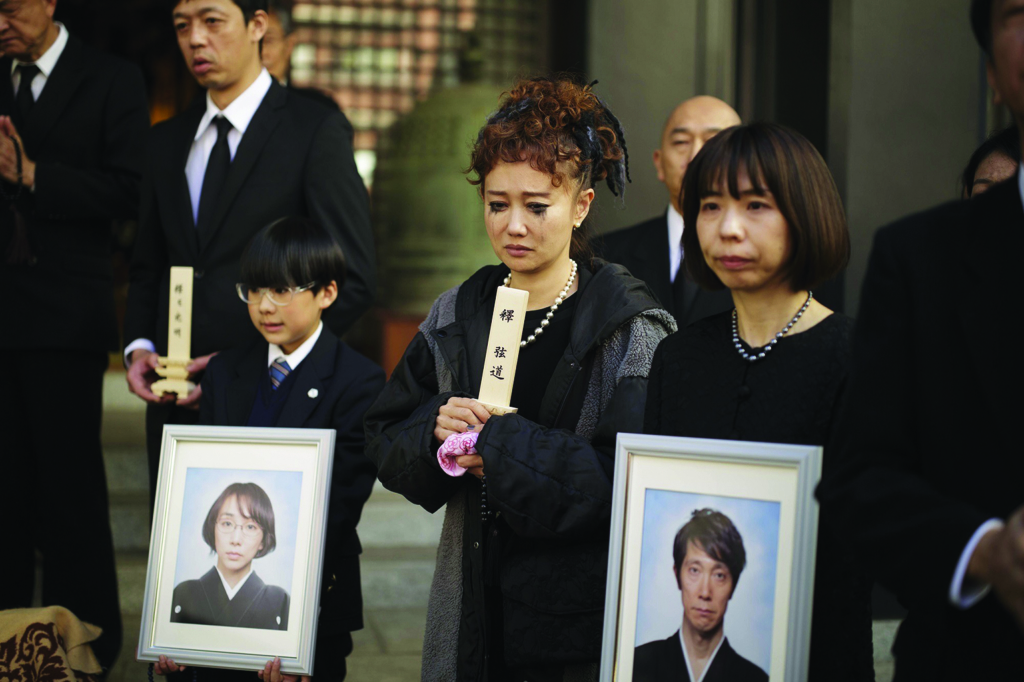
A motion-sickness-inducing skate-video sequence is shot using on-deck cameras with perspective-distorting fish-eye lenses. Camcorder visuals of a funeral are fast-forwarded through, and, late in the movie, when the grand ‘game’ of the narrative is started over, it begins again with footage of real hospital childbirth. There’s staged to-camera interviews, often set with a child wearing an outfit that matches a school-photo-style coloured backdrop. While there are images that plunge into black-and-white, colour grading is routinely bright, sometimes overtly harsh, oft deliberately surreal: from pink and purple skies to a ridiculously hued love hotel.
There are songs performed during the film – not by the titular band, but by other bands – proffering the notion that milk is the colour of love (although maybe it’s pink – milk mixed with blood) or the fact that an octopus is as smart as a three-year-old child. And Little Zombies’ members, in their weirdly giddy orphanhood, play a schoolyard-clapping-like song game called ‘Cause of Death’, in which they shout out various ways to die (‘Car crash. Fire. Suicide. Suffocation. Drowning. Eaten by bear’). The sound design – by Junnosuke Okita, working with Nagahisa – riffs not just on videogames’ 8-bit sounds, but on the hyperreality of autonomous sensory meridian response (ASMR), the dislocation between sound and vision, and the polyphonic cacophony of public space.
All of this isn’t just to be wacky, but to convey contemporary Japanese society’s noisy tenor – a climate of oversaturated visual and aural stimuli. The singular ‘screen’ of We Are Little Zombies is filled with a host of screens: phones, devices, handheld games, televisions, security monitors, giant video advertisements. In one heavily metaphorical sequence, the trope of zombies is evoked in a packed train station: here, the shuffling, lifeless horde is the commuters all walking slowly, staring down at their phones. As applied to the Little Zombies kids – bespectacled Hikari (Keita Ninomiya), portly Ishi (Satoshi Mizuno), rebellious Takemura (Mondo Okumura) and inscrutable, scissor-wielding ‘femme fatale’ Ikuko (Sena Nakajima) – the evocation of undeadness speaks to a lack of emotion. When Hikari doesn’t cry at his parents’ funeral, an aunt challenges him: ‘You should be crying. Are you dead inside?’ In turn, these themes capture a cold, uncaring society filled with increasing isolation and alienation, this ‘crazy Japanese’ film actually undertaking a serious exploration of the national psyche. In this vision of Japan, love is dismissed by tradition-upholding adults as a ‘Western invention’, and Hikari asks in voiceover: ‘Does sadness really exist?’
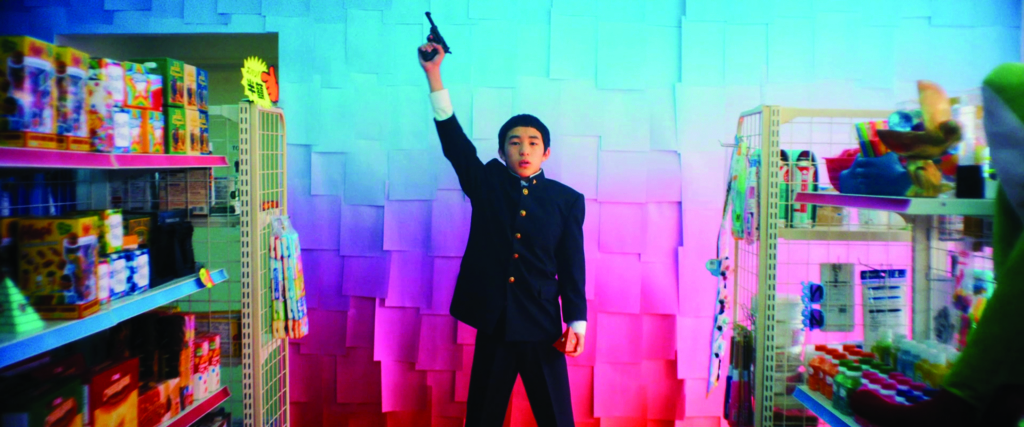
He and the rest of these ragtag orphans are struggling with a lack of the feels. ‘This is the story of four unemotional people,’ Hikari says in voiceover, the four members of Little Zombies meeting in the courtyard of a crematorium, united by the loss of their parents and by an absence of grief. An opening ‘stage’ – ‘Prologue: Why I Couldn’t Cry When My Parents Died’ – introduces us to Hikari. His parents had plentiful cash and got him all the tech toys he could ask for, but were emotionally distant and rarely home, leaving their solitary son in the care of his consoles (‘I was never loved,’ he narrates. ‘Games are my only friends’). They’ve just died in a bus crash while on a package tour to pick all-you-can-eat strawberries near Mount Fuji, which has led their only son to funerals and vigils and, eventually, to the other members of this newly formed gang. Ishi’s folksy, drunken, garrulous parents died during a gas explosion at their shanty-esque noodle stand / karaoke bar. Takemura’s abusive and neglectful parents (whose beatings are staged as Street Fighter–style stoushes), heavily in debt to loan sharks, suicided in their trash-heap home. And Ikuko’s parents were murdered by her piano teacher – a stalker sexually obsessed with his young student – perhaps, it’s intimated, at her behest.
These themes capture a cold, uncaring society filled with increasing isolation and alienation, this ‘crazy Japanese’ film actually undertaking a serious exploration of the national psyche. In this vision of Japan, love is dismissed by tradition-upholding adults as a ‘Western invention’.
Ikuko is the one who – an hour into this 120-minute film – comes up with the plan to form ‘a kickass band’, after earlier story stages find them acquiring the instruments they’ll use: Hikari’s ‘pocketboy’ gaming device, Ishi’s noodle-stand wok (to serve as percussion), Takemura’s bass guitar (stolen from an older brother) and the keyboard Ikuko once played for her creepy teacher. The idea comes to life when they’re hiding out in Trash Town, an abandoned half-built high-rise that’s a gathering place, and a refuge, for the orphaned and homeless who’ve slipped through the city’s cracks. From society’s trash – both human and literal – they fashion an ad-hoc ensemble, then recruit the nightwatchman of the site to film them in a ridiculous music video wherein homeless people shred on banjos and guitars with mutant second necks growing out of them, or bash on junk and cardboard boxes. The band is birthed in an explosion of colour and creativity, delivering its statement thesis – the song ‘We Are Little Zombies’ – to announce its existence. The (chip)tune may be the most memorable thing about the whole movie, whose repeated titular refrain, sung in English, makes for the kind of earworm that’ll burrow into viewers’ heads even after the movie’s finished.
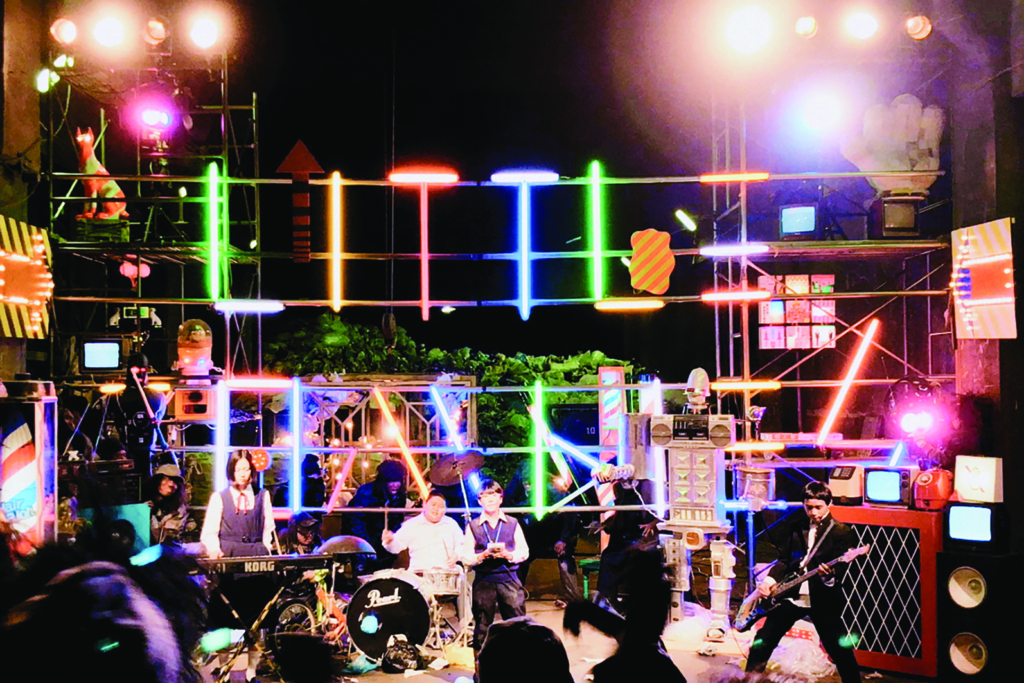
Beneath the music video’s colourful palette and hammered chorus, the lyrics – sung by Hikari – speak of the film’s darker themes. ‘Future, money, courage, love – don’t know what they are. Don’t know if I’m alive or dead,’ he sings. ‘Should be sad but tears won’t fall […] No hopes or dreams in the first place.’ In announcing their existence, the Little Zombies kids are undertaking a form of bloodletting: less a cry of rage, more a wail of ennui. Before the video’s even finished rolling in the movie, it’s a social-media storm – and, soon, music-biz vultures are circling. They speak about the zeitgeist and virality (and also The Shaggs!), and look to monetise building buzz, turning tragic backstory into marketable narrative (a second single, released later, is a ballad about dead parents that involves creating fake home-video fantasies of loving houses and supportive families).
Fame is almost instantaneous – ‘All the kids who made fun of us, all the classmates who looked down on us, all the adults who exploited us, all the relatives who abandoned us, our fake parents, we showed them all,’ Hikari says in voiceover; ‘we went from being poor zombies to glamorous rock stars’ – but proves fleeting. The band calls their debut album ‘Who Killed Them?’, evoking the deaths of their parents. This courts controversy, but also mobilises the mob of online Little Zombie fans, who look up the name of the bus driver responsible for the crash that killed Hikari’s parents, post his personal information online and start a campaign of Beyhive-style harassment.[2]Referring to the actions of some ardent fans of R & B superstar Beyoncé; see, for example, Mike Vulpo, ‘All the Times Beyoncé’s Beyhive Used Their Sting to Defend Their Queen’, E! News, 6 June 2019, <https://www.eonline.com/au/news/1047504/all-the-times-beyonce-s-beyhive-used-their-sting-to-defend-their-queen>, accessed 25 February 2020. When the driver, in response, takes his own life (after posting a public apology to social media), the bad press scuttles the fledgling band. ‘The adults made us cancel the tour and split up the band,’ Hikari laments. And so the kids burn their instruments, escape the authorities / commuter-zombies and go ‘Driving on the Death Road’ before coming back to life, like true zombies, in a world that’s forgotten about them.
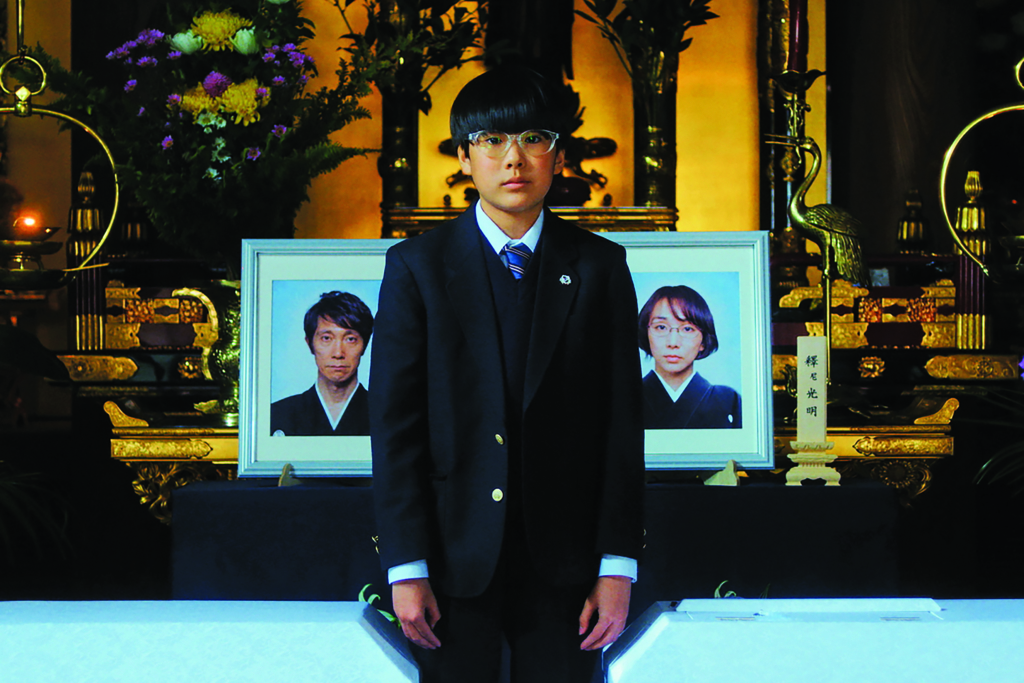
Hikari eventually comes to an understanding that the four orphans ‘formed this band as a way for us zombies to find out how to feel’, each effectively coming to terms with grief, and loss, in their own way. Along the way, there’s many realisations, and spoken evocations, of absence or insignificance (Hikari: ‘I’ve always been good at being invisible’; Ikuko: ‘Mum once told me that she wished I didn’t exist’; Takemura: ‘Everything that matters to me disappears’), the young charges coming to these feelings due to the support, the sense of community, they feel within the band. The bond proves permanent: in a final meta-movie sign-off, they pledge to deliver ‘one last song before the credits’, which plays out as they stride towards Mount Fuji, a symbolic destination that looms as a beckoning final stage. Like gamers, they deal with death, failure and the need to start all over again, but keep moving forever forward – into the great unknown of the rest of their lives.
Endnotes
| 1 | Makoto Nagahisa, via translator, in ‘Berlinale-2019 – We Are Little Zombies’, YouTube, 1 March 2019, <https://www.youtube.com/watch?v=0Mur9RW6GLw>, accessed 25 February 2020 |
|---|---|
| 2 | Referring to the actions of some ardent fans of R & B superstar Beyoncé; see, for example, Mike Vulpo, ‘All the Times Beyoncé’s Beyhive Used Their Sting to Defend Their Queen’, E! News, 6 June 2019, <https://www.eonline.com/au/news/1047504/all-the-times-beyonce-s-beyhive-used-their-sting-to-defend-their-queen>, accessed 25 February 2020. |
